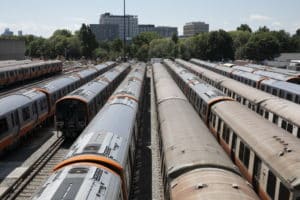
Trains are parked in the MBTA's Wellington Yard outside the Orange Line maintenance facility on Wednesday, Aug. 3, 2022. Photo by Chris Lisinski | State House News Service
The MBTA defied some riders’ pessimism to reopen its Orange Line subway line on schedule this morning, with service provided by a fleet of all-new trains.
A portion of the Green Line light rail system that connected Somerville’s Union Square to downtown Boston that was also closed for repairs during the shutdown will reopen tomorrow.
Two not-insignificant changes are coming thanks to the reopening: First, the CharlieCard Store customer service center will dramatically boost its operating hours and will now be open by appointment Monday, and open to all between 8:30 a.m. and 5 p.m. Tuesday-Friday.
Second, several stops added to commuter rail trains during the shutdown will continue in operation, with fares at those stops to and from downtown pegged to the cost of a subway ride. The move will offer Orange Line riders at the furthest ends of the line express-like service to downtown, bypassing many intermediate stops.
Haverhill Line commuter rail trains will stop at Malden’s Oak Grove station, in addition to Malden Center station. Trains on the Franklin and Providence/Stoughton lines will also continue to stop at Jamaica Plain’s Forest Hills station twice an hour during the morning rush hour.
However, the Orange Line will still be operating at the same, drastically reduced frequencies in effect this summer after the T was unable to train more dispatchers to fill posts in its subway control center, which coordinates traffic on the Orange, Red and Blue lines. According to the federal safety investigation, instead of training new staff, the T had been papering over gaps in its dispatching team by having existing employees work long shifts, sometimes up to 20 hours followed by only four hours off. Business-backed transit advocacy group A Better City has urged the T to bring in temporary workers to staff the control center to normal levels while it trains more. T officials claim they only have enough facilities to train six dispatchers at a time, a process that means full subway service will likely not resume until next year.
The Orange Line had been closed for a 30-day repair blitz after T leaders decided that drastic action was needed in the wake of a scathing federal safety inspection that identified numerous sections of dangerous track along the line, in addition to serious problems elsewhere in the agency. The closure was necessary, T leaders said, to make sure work crews had unimpeded access to the tracks instead of having to spend significant time setting up and taking down equipment to complete the work overnight or on weekends. A Better City and other transit advocates had criticized the move to extend the shutdown after Labor Day when many students and workers returned from summer breaks.
Unlike the Orange Line shutdown, the Green Line Extension to Union Square was closed so crews could fix mistakes made when installing the electrical lines that deliver power to trains before the line opened this spring, and complete work to connect another extension to Medford into the main line. Another portion of the Green Line, the D line connecting Newton to downtown Boston, will close from Sept. 24 to Oct. 30 so that work crews can replace track and station crossings, and install equipment for a long-delayed automated system designed to prevent the kinds of rear-ending crashes that have injured dozens one the line and even killed a trolley operator over the last 15 years.
“A tremendous amount of choreography, coordination, and hard work has been accomplished during these 30 days, including over a dozen projects to replace rail, track, signals, rail fasteners, and more that would have taken the T five years of nights and weekends to accomplish,” MBTA General Manager Steve Poftak said in a statement released by the T on Sunday. “We’ve also met our goal of eliminating six slow zones along the Orange Line, which creates faster and more reliable commutes for customers, and surpassed our goal for new vehicles with 72 new Orange Line cars ready to serve riders. Thank you to all of our partner municipalities along the Orange Line for collaborating with us throughout the entirety of these 30 days; to the MBTA workforce, contractor crews, shuttle bus operators, Transit Ambassadors, in-station personnel, and more for their dedicated work, skill, and service; and especially to our Orange Line riders – we’re excited to welcome you back to a faster, safer, more reliable ride tomorrow on a line comprised of predominantly new cars.”
T officials said the shutdown eliminated six areas of damaged or dangerous track that created slow zones along the line, replaced 14,000 feet of rail and 2,800 rail ties, performed deeper reconstruction on 3,500 additional feet of track, replaced 400 vibration-dampening rail fasteners called “Cologne Eggs” near Tufts Medical Center, upgraded signals on the northern end of the line from analog to digital systems and prepared for a similar project on the southern end of the line next year, repaired three deteriorating stations and more than doubled the number of new Orange Line cars available to run on the line – allowing a significant portion of the line’s rusting and incident-prone older fleet to be retired.
In a statement, the T noted that slow zones will remain in force for “about a week” more to allow new track and the ballast that supports it to settle.
“We are pleased the Orange Line re-opened and a number of the T’s safety and maintenance goals were advanced along the corridor,” A Better City CEO Rick Dimino said in an emailed statement. “This progress was achieved with both substantial and unspoken impacts, including serious travel time impacts, congestion, and economic harm. Targeted shutdowns need to happen with more advance notice, more appropriately scheduled, shorter durations, stronger communication, and enhanced alternative service and mitigation. A silver lining coming out of this was increased use and associated local stops added to Commuter Rail and a tremendous uptick in Bluebike use. More efforts to continue these trends will be a step in the right direction.”





